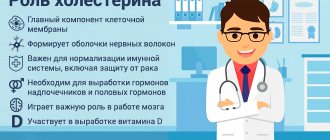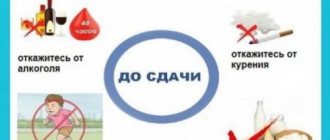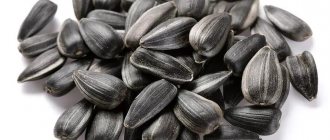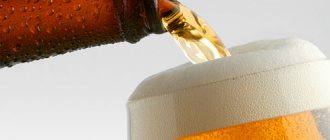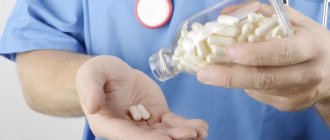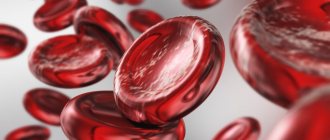Cholesterol is an organic substance that is part of cell membranes and is necessary for the functioning of all cells in the body. Cholesterol is a natural alcohol that is insoluble in water, but soluble in fats and organic solvents. Most of the cholesterol necessary for the functioning of the body is synthesized in the liver from fats, glucose and amino acids, and it also enters the body with food. Up to 2.5 g of cholesterol is synthesized in the body per day, about 0.5 g comes from food.
Cholesterol is an extremely important substance for the functioning of the entire body: it ensures the stability of cell membranes, is involved in the production of vitamin D, and is necessary for the production of various hormones by the adrenal glands. In the body, cholesterol is carried by lipoproteins, which have two fractions: low density (LDL) and high density (HDL). Low-density lipoproteins (called “bad cholesterol”) contribute to the deposition of cholesterol on the walls of blood vessels and the formation of atherosclerotic plaques. These plaques narrow the lumen of the vessel and interfere with normal blood flow, complicating or completely cutting off the nutrition of tissues and organs. High-density lipoproteins (“good cholesterol”) do not “clog” blood vessels, but, on the contrary, capture and remove cholesterol deposits that accumulate on the walls of blood vessels.
Elevated levels of cholesterol in the blood are dangerous - it is one of the main causes of the development of atherosclerosis, which, in turn, leads to the development of cardiovascular diseases, heart attacks and strokes, brain disorders and other diseases.
The level of cholesterol in the blood depends on many factors - genetic predisposition, gender, presence of chronic diseases, diet, age, lifestyle and physical activity.
Cholesterol norm
The normal levels of cholesterol in the blood are determined separately for women and men, and also depend on the person’s age. The established standards were adopted on the basis of scientific analysis of the results of laboratory tests of a large number of patients. The cholesterol level can fluctuate in the range of 3.6-7.8 mmol/l. However, doctors say that any cholesterol level above 6 mmol/l is considered elevated. Many patients taking a cholesterol test already have chronic diseases, especially for older people, so only a specialist can determine the individual norm.
A blood test determines:
- High density lipoproteins.
- Low density lipoproteins.
- Total cholesterol level.
- Triglycerides.
How to lower cholesterol with medications
If the patient follows the recommendations given above, but cholesterol does not decrease, the doctor prescribes medication. It includes:
Statins . The substances block the liver enzyme that produces cholesterol. After taking them, new portions of cholesterol do not enter the blood, and the already accumulated cholesterol is gradually eliminated.
Niacin . Vitamin B blocks the release of fats from fiber into the blood and suppresses the production of cholesterol in the liver. Due to this, its level in the vessels decreases.
Bile acid sequestrants . They bind bile acids in the liver and remove them. Bile acids are produced during the metabolism of cholesterol and fats; when they are removed from the body, cholesterol drops.
All medications have contraindications. Self-selecting and taking medications can have negative health consequences. Before use, consult a cardiologist.
Doctors at the Medicenter clinic network will prescribe a biochemical blood test to determine your cholesterol level. Patients with elevated levels will receive individual recommendations on how to lower cholesterol, taking into account lifestyle, predisposition and health status.
Why is high cholesterol dangerous?
An increased level of “bad” cholesterol in the blood contributes to the formation of atherosclerotic plaques and the development of atherosclerotic damage to the walls of blood vessels. With the development of atherosclerosis, the main function of the vessels that deliver blood to each cell is disrupted, providing nutrition to the whole body. The consequences depend on the location of the largest accumulation of plaques:
- Cerebral vessels - a violation of cerebral circulation, which leads to stroke and cognitive impairment.
- Heart vessels - angina pectoris, heart attack, hypertension.
- Renal vessels – chronic renal failure.
- Retinal vessels – decreased vision.
- Intestinal vessels - thrombosis, colic.
- Vessels of the lower extremities - gangrene, necrosis.
People at risk include:
- Those with a genetic predisposition (close relatives with atherosclerosis and cardiovascular diseases).
- Overweight.
- With high blood pressure.
- With type 2 diabetes.
- Leading a sedentary lifestyle.
- Eating “junk” food.
- Having bad habits - smoking, alcohol.
- Men over 35 years old.
- Women who have been taking hormonal contraceptives for a long time and women in menopause.
After 40 years
The normal level of total cholesterol in men after 40-45 years is in the range of 4.2-7.2 mmol/l. and the likelihood of full-blown deviations at this age increases.
As a rule, patients encounter three disorders:
Cardiac ischemia
It develops against the background of blockage of the coronary arteries by cholesterol plaques. This is an extremely dangerous pathological process. On the other hand, it develops gradually, so there is every chance to notice something is wrong and consult a doctor.
The symptoms of the disorder are quite typical and are well differentiated even by the patient himself.
- Chest pain. Intense, diffuse character. Often localized to one specific point. Just above the epigastric region.
- Discomfort in the area of the left shoulder or arm in general. Unpleasant sensations can radiate to the limbs.
- Disturbances in normal breathing.
- Also decreased performance. The patient constantly or most of the time wants to sleep, and cannot perform even the simplest work.
- Exercise intolerance. Or a decrease in tolerance to mechanical activity. At advanced stages of the pathological process, the patient cannot get out of bed because symptoms such as shortness of breath begin.
- Disturbance of normal heart rhythm. Tachycardia develops. In this way, the heart tries to compensate for the lack of nutrients. Restore trophism and cellular respiration. This is not enough for a long time, so the opposite phenomenon occurs.
- Bradycardia. Decreased heart rate. Develops spontaneously after a long time.
Coronary heart disease is treated by a cardiologist. Conservative therapy is prescribed. In the early stages, cardioprotectors and means to protect the organ are indicated.
If it is ineffective or if the pathological process is advanced, surgery is prescribed. As a rule, they are limited to bypass surgery. They pave an additional path for liquid connective tissue.
Thus, the heart receives a normal amount of blood with nutrients and oxygen.
Hypertonic disease
A chronic disorder characterized by increased blood pressure. In this case, we are talking about a full-fledged disease, and not about a simple phenomenon.
The condition is stable (in the negative sense) and highly dangerous for the patient.
As a rule, there is a group of symptoms:
- Headache. Discomfortable sensations in the skull area. They can be very different: pinpoint, diffuse. Depends on the individual characteristics of the patient’s body.
- Heart rhythm disturbance. Due to increased load on cardiac structures.
- Dizziness. Feeling of the world spinning before your eyes.
- Intolerance to sharp sounds and smells. Especially at the peak of rising blood pressure.
- Nausea.
- Vomiting is possible, but not always.
Symptoms such as weakness and drowsiness will certainly develop. With a long course of the pathological process, the patient simply does not notice many manifestations.
This is a bad sign because the body adapts to high blood pressure levels.
Then, after treatment, it will be difficult to live with normal blood pressure. Your health will change and you will have to get used to the condition again.
Treatment is carried out under the supervision of a cardiologist. In some cases, a neurologist comes into play in order to achieve a greater therapeutic result.
Several types of drugs are prescribed. Calcium channel blockers, centrally acting agents, sartans, ACE inhibitors, diuretics, if necessary.
Correction of pressure is a mandatory measure, since without special help there is a high probability of emergency conditions: heart attack, stroke.
Atherosclerosis
{banner_banstat9}
A classic disease associated with lipid metabolism disorders. Develops as a result of a metabolic disorder.
Fats are stored in excess quantities. Some of the substance is deposited on the walls of blood vessels and large arteries.
In the early stages of hypercholesterolemia, there are no symptoms of the disorder yet. As soon as the pathological process is sufficiently developed, characteristic signs will appear:
- Headache. Usually strong.
- Nausea.
- Vomit.
- Weakness and drowsiness.
- Heart rhythm disturbances.
- Sensation of pulsation in the throat or neck vessels.
- Problems with thinking. By memory. Cognitive functions in general.
Treatment is carried out using special drugs. Statins are used to help clear plaques faster. Also fibrates if the first means are ineffective. Be sure to use nicotinic acid.
It is important that the patient eats a nutritious diet that is low in fat and carbohydrates. Preference is given to plant products.
Recovery takes place under the supervision of an endocrinologist.
Basic principles of a diet for high cholesterol
According to doctors, diet is an effective way to reduce the level of “bad” cholesterol in the blood. The main task of such a diet is to provide complete, balanced nutrition while limiting the intake of cholesterol into the body. This diet is called an antiatherogenic or antiatherosclerotic diet. Here are its basic principles:
- The amount of fat in the diet should be less than 30% of total calories, and saturated fat - less than 10%. To do this, you need to choose lean varieties of meat - lean poultry, rabbit meat, veal. Before cooking, trim off any fat from the meat. Increase the proportion of fish in your diet.
- Reducing your overall caloric intake to prevent excess weight gain. If a diet is prescribed in the presence of excess weight, then the calorie content is calculated in such a way that gradual weight loss occurs, and when the norm is reached, it is maintained.
- Frequent meals in small portions without overeating, 5-6 meals a day.
- Exclusion of foods rich in saturated fats - fatty meats, lard, egg yolk, cheese, full-fat dairy products, butter, processed meat products (sausages, sausages), caviar, coconut and palm oil. They are the main source of “bad” cholesterol.
- Avoiding trans fats, the consumption of which increases the risk of cardiovascular disease. Trans fats are found in margarine, baked goods, confectionery products, and many prepared foods containing vegetable oils (information about trans fat content must be indicated on the packaging).
- Reducing the consumption of simple carbohydrates - refined cereals, flour, refined sugar, sweets, fruit juices and carbonated drinks.
- Introducing foods containing Omega-3 polyunsaturated fatty acids into the diet. They are found in fatty fish - salmon, tuna, sardine, herring, mackerel, mackerel, and in smaller quantities in flaxseed oil, soybeans, avocados, spinach, broccoli, and nuts. You can take Omega-3 vitamin in capsules.
- The basis of the diet is foods high in complex carbohydrates and fiber: whole grain bread, cereals, vegetables, fruits, herbs, legumes. Of the legumes, soybean is the most useful - its biological active substances help reduce cholesterol levels. Soy is also an excellent source of complete protein, which can replace one of the meat meals.
Importance for the body
Many people have the misconception that cholesterol is extremely dangerous and harmful to health. It comes in with food. And it is necessary to take all measures to avoid the accumulation of this substance in the body. The statements are half true.
Cholesterol is an organic, fatty compound that helps in metabolism and promotes the normal functioning of internal organs. About 20% of lipid compounds enter the body with food, the remaining 80% are produced independently. Synthesis occurs in the intestines and liver.
Functionality
The connection plays an important role in life:
- Participates in fat metabolism and promotes uniform distribution of lipids;
- Breaks down fat-soluble vitamins and transports them throughout the body;
- Produces structures from which the cell membrane is built, protecting against external influences. Cell permeability and vulnerability depend on its thickness. A sufficient amount of cholesterol helps strengthen the membrane, making it durable.
- Regulates cell permeability for the intake of nutrients and the excretion of synthesized compounds;
- It is part of the myelin sheaths, which serve as a protective layer of nerve fibers;
- Thanks to this organic compound, the sun's rays, namely ultraviolet radiation, are converted into vitamin D in the body;
- Helps in the formation of bile and promotes the correct elimination process;
- Plays an important role in the protection of red blood cells, protecting red blood cells from toxins, viruses, bacteria;
- The production of sex hormones, adrenaline and norepinephrine occurs with the participation of cholesterol;
- A good mood also depends on the amount of this substance in the body. It is involved in the work of serotonin receptors, responsible for their normal functioning;
- Ensures the performance of the entire body, starting from the cellular level and ending with muscle function and the strength of the bone skeleton;
- Thanks to its presence, the synthesis of hormones and the absorption of vitamins is possible. Correct metabolism occurs, metabolic rate is regulated;
In the fight against fat deposits, the presence of cholesterol has a beneficial effect. It promotes the formation of fatty acids and the breakdown of fats that enter the body with food.
Thus, cholesterol is an important component of our body. And what high cholesterol means for health is not difficult to answer.
